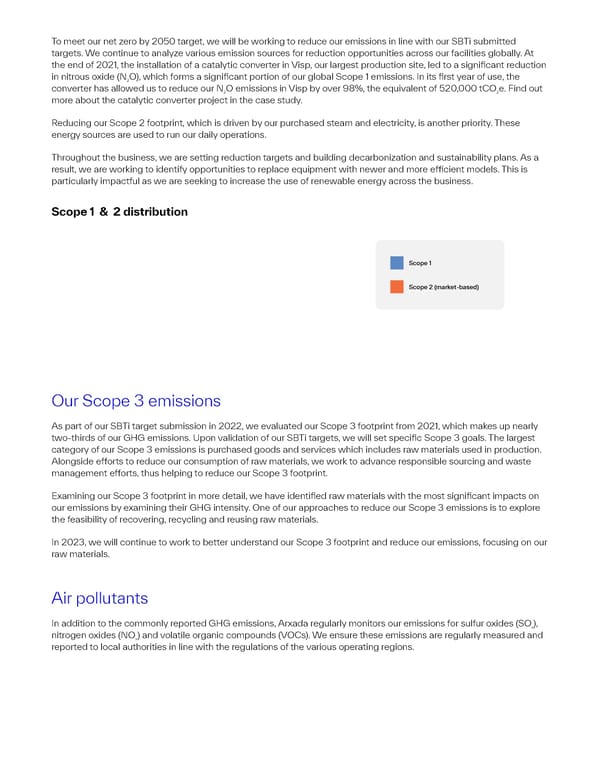To meet our net zero by 2050 target, we will be working to reduce our emissions in line with our SBTi submied targets. We continue to analyze various emission sources for reduction opportunities across our facilities globally. At the end of 2021, the installation of a catalytic converter in Visp, our largest production site, led to a significant reduction in nitrous oxide (N O), which forms a significant portion of our global Scope 1 emissions. In its first year of use, the 2 converter has allowed us to reduce our N O emissions in Visp by over 98%, the equivalent of 520,000 tCO e. Find out 2 2 more about the catalytic converter project in the case study. Reducing our Scope 2 footprint, which is driven by our purchased steam and electricity, is another priority. These energy sources are used to run our daily operations. Throughout the business, we are seing reduction targets and building decarbonization and sustainability plans. As a result, we are working to identify opportunities to replace equipment with newer and more ecient models. This is particularly impacul as we are seeking to increase the use of renewable energy across the business. Scope 1 & 2 distribution Scope 1 Scope 2 (market-based) Our Scope 3 emissions As part of our SBTi target submission in 2022, we evaluated our Scope 3 footprint from 2021, which makes up nearly two-thirds of our GHG emissions. Upon validation of our SBTi targets, we will set specific Scope 3 goals. The largest category of our Scope 3 emissions is purchased goods and services which includes raw materials used in production. Alongside eorts to reduce our consumption of raw materials, we work to advance responsible sourcing and waste management eorts, thus helping to reduce our Scope 3 footprint. Examining our Scope 3 footprint in more detail, we have identified raw materials with the most significant impacts on our emissions by examining their GHG intensity. One of our approaches to reduce our Scope 3 emissions is to explore the feasibility of recovering, recycling and reusing raw materials. In 2023, we will continue to work to beer understand our Scope 3 footprint and reduce our emissions, focusing on our raw materials. Air pollutants In addition to the commonly reported GHG emissions, Arxada regularly monitors our emissions for sulfur oxides (SO), x nitrogen oxides (NO) and volatile organic compounds (VOCs). We ensure these emissions are regularly measured and x reported to local authorities in line with the regulations of the various operating regions.
 2022 Sustainability Report | The Power of Science & Sustainability Page 16 Page 18
2022 Sustainability Report | The Power of Science & Sustainability Page 16 Page 18